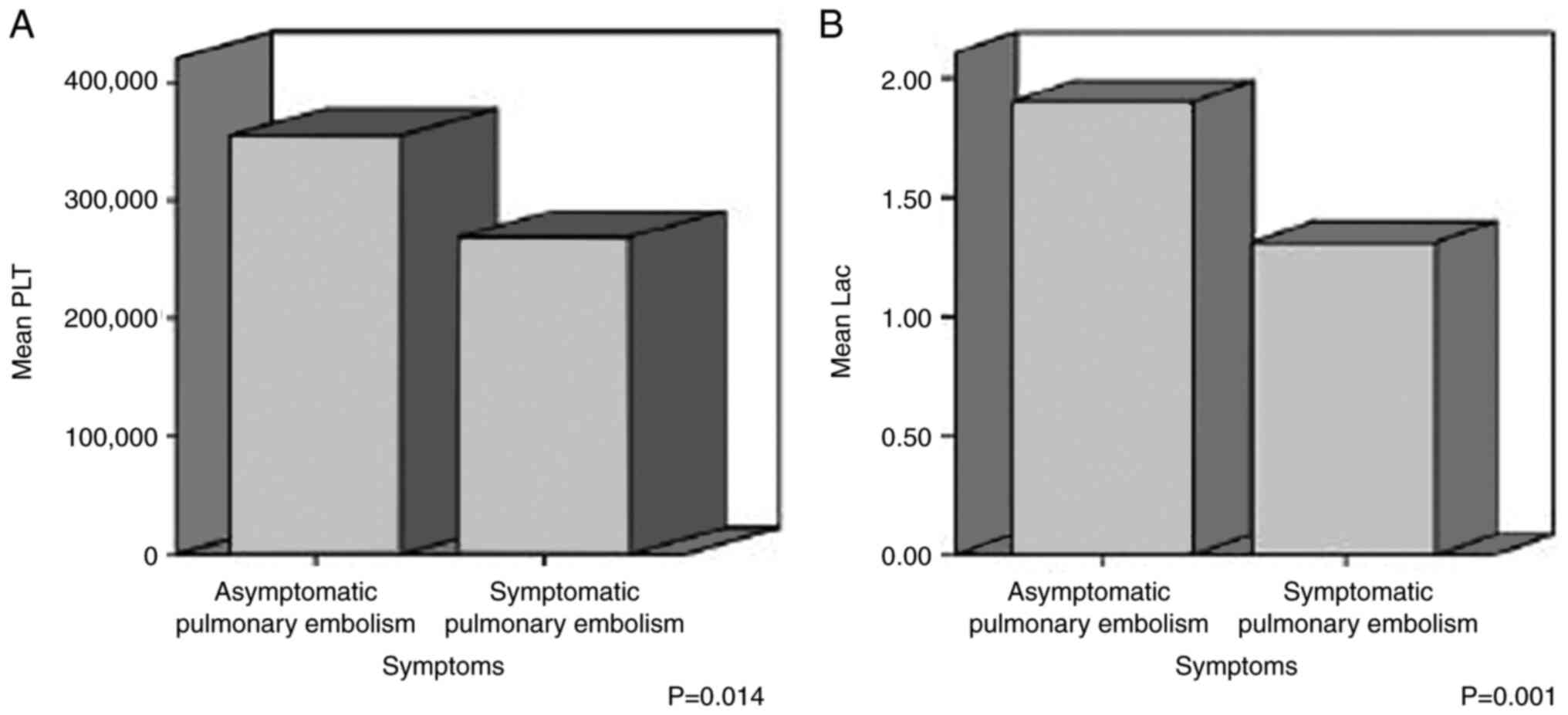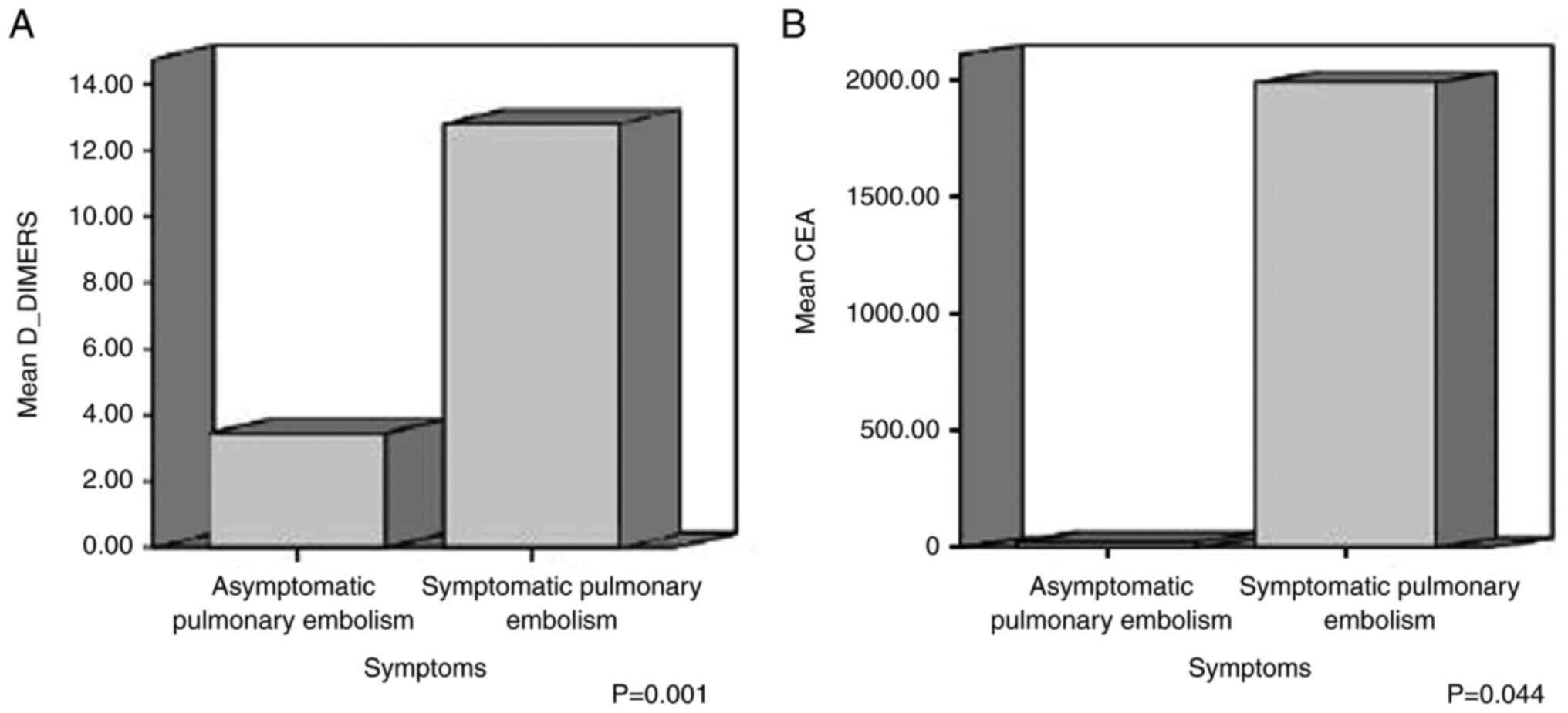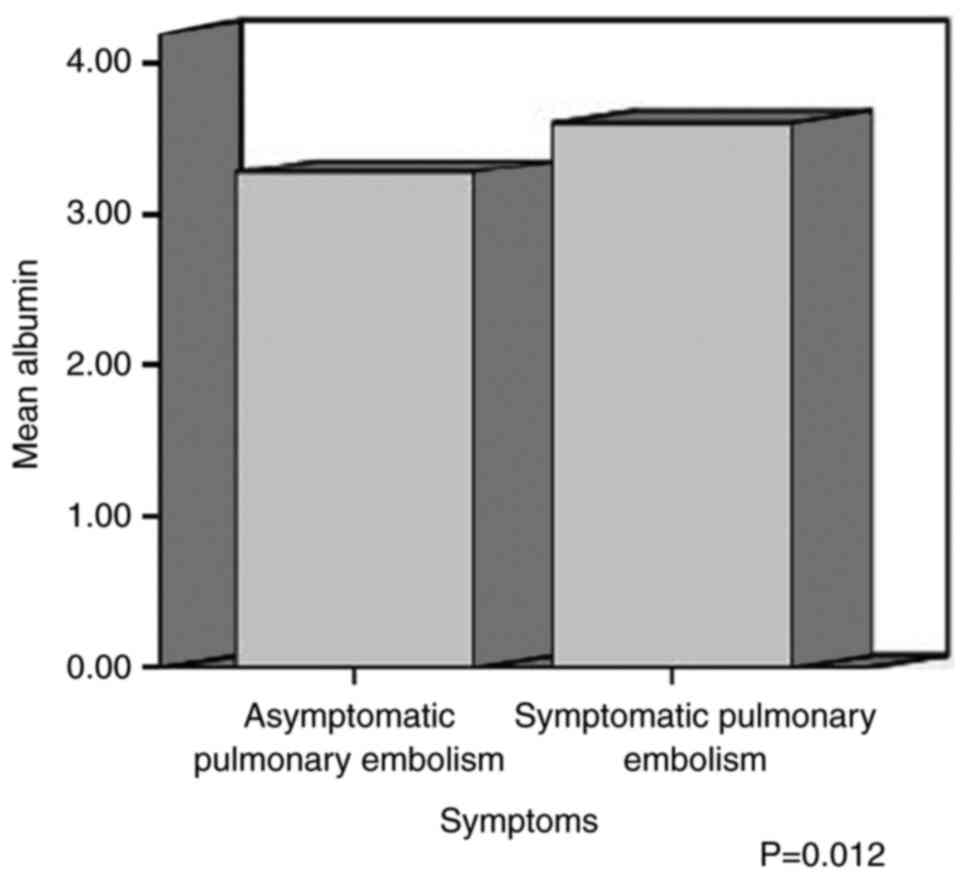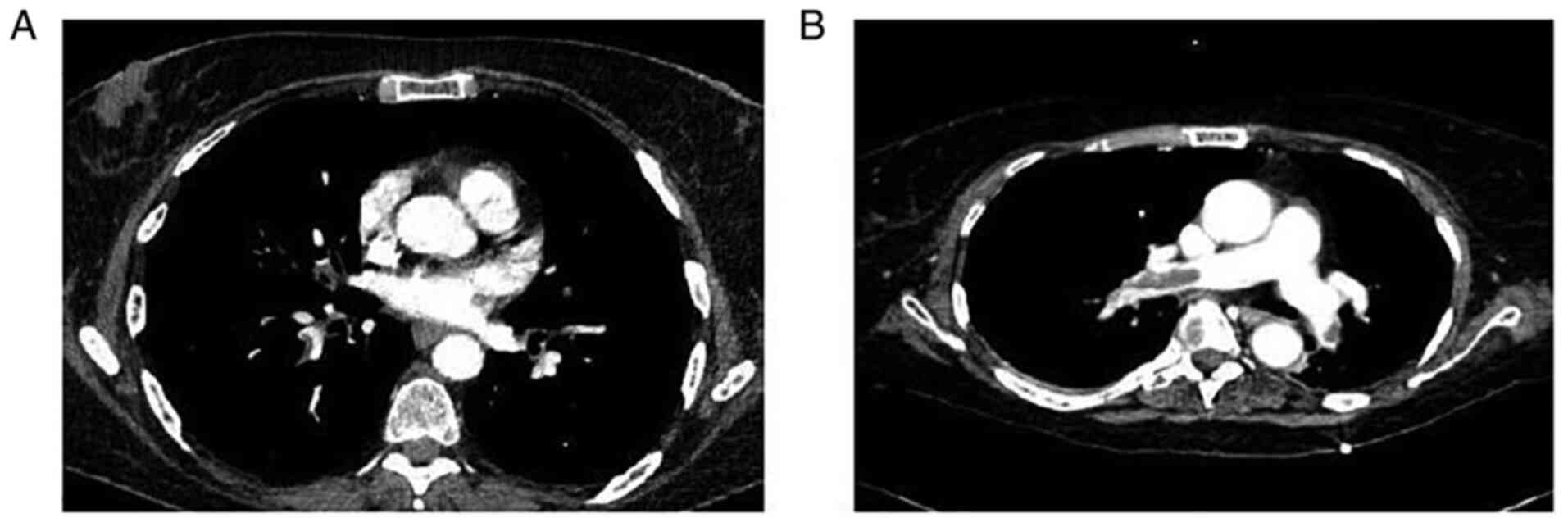|
1
|
Essien EO, Rali P and Mathai SC: Pulmonary
embolism. Med Clin North Am. 103:549–564. 2019. View Article : Google Scholar : PubMed/NCBI
|
|
2
|
Blom JW, Doggen CJ, Osanto S and Rosendaal
FR: Malignancies, prothrombotic mutations, and the risk of venous
thrombosis. JAMA. 293:715–722. 2005. View Article : Google Scholar : PubMed/NCBI
|
|
3
|
Goldhaber SZ: Risk factors for venous
thromboembolism. J Am Coll Cardiol. 56:1–7. 2010. View Article : Google Scholar : PubMed/NCBI
|
|
4
|
Silva P, Rosales M, Milheiro MJ and Santos
LL: Pulmonary embolism in ambulatory oncologic patients. Acta Med
Port. 28:463–468. 2015. View Article : Google Scholar : PubMed/NCBI
|
|
5
|
Gladish GW, Choe DH, Marom EM, Sabloff BS,
Broemeling LD and Munden RF: Incidental pulmonary emboli in
oncology patients: Prevalence, CT evaluation, and natural history.
Radiology. 240:246–255. 2006. View Article : Google Scholar : PubMed/NCBI
|
|
6
|
Abdol Razak NB, Jones G, Bhandari M,
Berndt MC and Metharom P: Cancer-associated thrombosis: An overview
of mechanisms, risk factors, and treatment. Cancers (Basel).
10:3802018. View Article : Google Scholar : PubMed/NCBI
|
|
7
|
Bloom J, Doggen C and Rosendaal F: The
risk of venous thrombosis in cancer patients with or without the
factor V Leiden mutation. Haemostasis. 31:732001.
|
|
8
|
Tsoukalas N, Tsapakidis K, Galanopoulos M,
Karamitrousis E, Kamposioras K and Tolia M: Real world data
regarding the management of cancer-associated thrombosis. Curr Opin
Oncol. 32:289–294. 2020. View Article : Google Scholar : PubMed/NCBI
|
|
9
|
Anagnostopoulos I, Lagou S, Spanorriga MK,
Tavernaraki K, Poulakou G, Syrigos KN and Thanos L: Epidemiology
and diagnosis of pulmonary embolism in lung cancer patients: Is
there a role for age adjusted D-dimers cutoff? J Thromb
Thrombolysis. 49:572–577. 2020. View Article : Google Scholar : PubMed/NCBI
|
|
10
|
Miller GA, Sutton GC, Kerr IH, Gibson RV
and Honey M: Comparison of streptokinase and heparin in treatment
of isolated acute massive pulmonary embolism. Br Med J. 2:681–684.
1971. View Article : Google Scholar : PubMed/NCBI
|
|
11
|
Krilokuva I: Pulmonary embolism (acute or
chronic). J Respir Dis Med. 2:1–3. 2019.
|
|
12
|
Aleem A, Al Diab AR, Alsaleh K, Algahtani
F, Alsaeed E, Iqbal Z and El-Sherkawy MS: Frequency, clinical
pattern and outcome of thrombosis in cancer patients in Saudi
Arabia. Asian Pac J Cancer Prev. 13:1311–1315. 2012. View Article : Google Scholar : PubMed/NCBI
|
|
13
|
Ohashi Y, Ikeda M, Kunitoh H, Sasako M,
Okusaka T, Mukai H, Fujiwara K, Nakamura M, Oba MS, Kimura T, et
al: Venous thromboembolism in cancer patients: Report of baseline
data from the multicentre, prospective cancer-VTE Registry. Jpn J
Clin Oncol. 50:1246–1253. 2020. View Article : Google Scholar : PubMed/NCBI
|
|
14
|
Meyer HJ, Wienke A and Surov A: Incidental
pulmonary embolism in oncologic patients-a systematic review and
meta-analysis. Support Care Cancer. 29:1293–1302. 2021. View Article : Google Scholar : PubMed/NCBI
|
|
15
|
Myat Moe MM and Redla S: Incidental
pulmonary embolism in oncology patients with current macroscopic
malignancy: Incidence in different tumour type and impact of
delayed treatment on survival outcome. Br J Radiol.
91:201708062018. View Article : Google Scholar : PubMed/NCBI
|
|
16
|
Abdel-Razeq HN, Mansour AH and Ismael YM:
Incidental pulmonary embolism in cancer patients: Clinical
characteristics and outcome-a comprehensive cancer center
experience. Vasc Health Risk Manag. 7:153–158. 2011. View Article : Google Scholar : PubMed/NCBI
|
|
17
|
van Es N, Bleker SM and Di Nisio M:
Cancer-associated unsuspected pulmonary embolism. Thromb Res. 133
(Suppl 2):S172–S178. 2014. View Article : Google Scholar : PubMed/NCBI
|
|
18
|
Kline JA, Mitchell AM, Kabrhel C, Richman
PB and Courtney DM: Clinical criteria to prevent unnecessary
diagnostic testing in emergency department patients with suspected
pulmonary embolism. J Thromb Haemost. 2:1247–1255. 2004. View Article : Google Scholar : PubMed/NCBI
|
|
19
|
Douma RA, Gibson NS, Gerdes VE, Büller HR,
Wells PS, Perrier A and Le Gal G: Validity and clinical utility of
the simplified Wells rule for assessing clinical probability for
the exclusion of pulmonary embolism. Thromb Haemost. 101:197–200.
2009. View Article : Google Scholar : PubMed/NCBI
|
|
20
|
Klok FA, Mos IC, Nijkeuter M, Righini M,
Perrier A, Le Gal G and Huisman MV: Simplification of the revised
Geneva score for assessing clinical probability of pulmonary
embolism. Arch Intern Med. 168:2131–2136. 2008. View Article : Google Scholar : PubMed/NCBI
|
|
21
|
Awkar N, Amireh S, Rai S, Shaaban H, Guron
G and Maroules M: Association between level of tumor markers and
development of VTE in patients with pancreatic, colorectal and
ovarian Ca: Retrospective case-control study in two community
hospitals. Pathol Oncol Res. 24:283–287. 2018. View Article : Google Scholar : PubMed/NCBI
|
|
22
|
Xiong W, Zhao Y, Xu M, Guo J, Pudasaini B,
Wu X and Liu J: The relationship between tumor markers and
pulmonary embolism in lung cancer. Oncotarget. 8:41412–41421. 2017.
View Article : Google Scholar : PubMed/NCBI
|
|
23
|
Vanni S, Viviani G, Baioni M, Pepe G,
Nazerian P, Socci F, Bartolucci M, Bartolini M and Grifoni S:
Prognostic value of plasma lactate levels among patients with acute
pulmonary embolism: The thrombo-embolism lactate outcome study. Ann
Emerg Med. 61:330–338. 2013. View Article : Google Scholar : PubMed/NCBI
|
|
24
|
Vanni S, Socci F, Pepe G, Nazerian P,
Viviani G, Baioni M, Conti A and Grifoni S: High plasma lactate
levels are associated with increased risk of in-hospital mortality
in patients with pulmonary embolism. Acad Emerg Med. 18:830–835.
2011. View Article : Google Scholar : PubMed/NCBI
|
|
25
|
Galić K, Pravdić D, Prskalo Z, Kukulj S,
Starčević B and Vukojević M: Prognostic value of lactates in
relation to gas analysis and acid-base status in patients with
pulmonary embolism. Croat Med J. 59:149–155. 2018. View Article : Google Scholar : PubMed/NCBI
|
|
26
|
Ząbczyk M, Natorska J, Janion-Sadowska A,
Malinowski KP, Janion M and Undas A: Elevated lactate levels in
acute pulmonary embolism are associated with prothrombotic fibrin
clot properties: Contribution of NETs formation. J Clin Med.
9:9532020. View Article : Google Scholar : PubMed/NCBI
|
|
27
|
Omar HR, Mirsaeidi M, Rashad R, Hassaballa
H, Enten G, Helal E, Mangar D and Camporesi EM: Association of
serum albumin and severity of pulmonary embolism. Medicina
(Kaunas). 56:262020. View Article : Google Scholar : PubMed/NCBI
|
|
28
|
Chi G, Gibson CM, Liu Y, Hernandez AF,
Hull RD, Cohen AT, Harrington RA and Goldhaber SZ: Inverse
relationship of serum albumin to the risk of venous thromboembolism
among acutely ill hospitalized patients: Analysis from the APEX
trial. Am J Hematol. 94:21–28. 2019. View Article : Google Scholar : PubMed/NCBI
|
|
29
|
Königsbrügge O, Posch F, Riedl J, Reitter
EM, Zielinski C, Pabinger I and Ay C: Association between decreased
serum albumin with risk of venous thromboembolism and mortality in
cancer patients. Oncologist. 21:252–257. 2016. View Article : Google Scholar : PubMed/NCBI
|
|
30
|
Li G, Li Y and Ma S: Lung cancer
complicated with asymptomatic pulmonary embolism: Clinical analysis
of 84 patients. Technol Cancer Res Treat. 16:1130–1135. 2017.
View Article : Google Scholar : PubMed/NCBI
|
|
31
|
Ali S, Dilday E, Tagawa S, Akhtar NH,
Liebman HA, Razavi P, Rochanda L, Quinn DI, Seaton K and O'Connell
CL: D-dimer levels among cancer patients with unsuspected pulmonary
embolism: Clinical correlates and relevance. Blood. 120:11542012.
View Article : Google Scholar : PubMed/NCBI
|
|
32
|
Greenberg CS: The role of D-dimer testing
in clinical hematology and oncology. Clin Adv Hematol Oncol.
15:580–583. 2017.PubMed/NCBI
|
|
33
|
Font C, Carmona-Bayonas A, Beato C, Reig
Ò, Sáez A, Jiménez-Fonseca P, Plasencia JM, Calvo-Temprano D,
Sanchez M, Benegas M, et al: Clinical features and short-term
outcomes of cancer patients with suspected and unsuspected
pulmonary embolism: The EPIPHANY study. Eur Respir J.
49:16002822017. View Article : Google Scholar : PubMed/NCBI
|
|
34
|
Wang H, Xu X, Pu C and Li L: Clinical
characteristics and prognosis of cancer patients with venous
thromboembolism. J Can Res Ther. 15:344–349. 2019.PubMed/NCBI
|


















